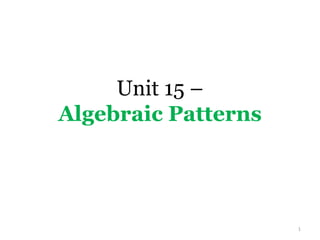
What are sequences?
- 1. Unit 15 – Algebraic Patterns 1
- 2. DO NOW ”4 in 4” Unit 15 Pretest 1. Which ordered pair completes 3. What is the rule for the pattern the table? in the table below? x y x y A. x+4 1 6 7 0 B. x–4 A. (2, 16) 2 7 5 4 C. x+5 B. (-1, 16) 3 8 3 8 D. x–5 C. (1, -16) 4 9 1 12 D. (-1, -16) 4. What is the rule for the pattern 2. What pattern is shown in the in the table below? table in Question 1? x y A. Add 2 to each x, Subtract 4 from 2 -1 each y A. x+3 4 1 B. Add 2 to each x, Add 4 to each y B. x–3 6 3 C. Subtract 2 from each x, Subtract C. x●3 4 from each y 8 5 D. x÷3 D. Subtract 2 from each x, Add 4 to each y 2
- 3. DO NOW ”4 in 4” 3. What is the rule for the pattern answers 1. Which ordered pair completes the table? in the table below? x y x y A. x+4 1 6 7 0 B. x–4 A. (2, 16) 2 7 5 4 C. x+5 B. (-1, 16) 3 8 3 8 D. x–5 C. (1, -16) 4 9 1 12 D. (-1, -16) 4. What is the rule for the pattern 2. What pattern is shown in the in the table below? table in Question 1? x y A. Add 2 to each x, Subtract 4 from 2 -1 each y A. x+3 4 1 B. Add 2 to each x, Add 4 to each y B. x–3 C. Subtract 2 from each x, Subtract 6 3 C. x●3 4 from each y D. x÷3 8 5 D. Subtract 2 from each x, Add 4 to each y 3
- 5. HOMEWORK HW #9 Algebra: Linear Functions Prerequisites worksheet 5
- 6. MINI LESSON A sequence is an ordered list of numbers. Each number is called a term. An arithmetic sequence is a sequence in which the difference between any two consecutive terms is the same. *adding or subtracting The difference is called the common difference. 6
- 7. MINI LESSON (cont.) A geometric sequence is a sequence in which the quotient between any two consecutive terms is the same. *Multiplying or dividing The quotient is called the common ratio. 7
- 8. MINI LESSON (cont.) Consider the following pattern: 1. Continue the pattern for 4, 5, and 6 triangles. How many toothpicks are needed for each case? 2. Study the pattern of numbers. How many toothpicks will you need for 7 triangles? 3. Continue the pattern for 4, 5, Now, consider another pattern: and 6 triangles. How many toothpicks are needed for each case? 4. How many toothpicks will you need for 7 squares? 8
- 9. WE DO State whether the following sequences are arithmetic or geometric. Then state the common difference or ratio. Finally, write the next three terms of the sequence. 1. 17, 12, 7, 2, -3, … 2. 96, -48, 24, -12, 6, … 3. 2, 4, 12, 48, 240, … 9
- 10. YOU DO State whether each sequence is arithmetic, geometric, or neither. If it is arithmetic or geometric, state the common difference or common ratio. Write the next three terms of each sequence. 1. 2, 4, 6, 8, 10, … 2. 11, 4, -2, -7, -11, … 3. 3, -6, 12, -24, 48, … 4. 20, 24, 28, 32, 36, … 5. 1, 10, 100, 1,000, 10,000, … 6. 486, 162, 54, 18, 6, … 7. 88, 85, 82, 79, 76, … 8. 1, 1, 2, 6, 24, … 9. 1, 2, 5, 10, 17, … 10.-6, -4, -2, 0, 2, … 10
- 11. YOU DO (cont.) State whether each sequence is arithmetic, geometric, or neither. If it is arithmetic or geometric, state the common difference or common ratio. Write the next three terms of each sequence. 11. 5, -15, 45, -135, 405, … 12.189, 63, 21, 7, 2.3, … 13.4, 6.5, 9, 11.5, 14, … 14.-1, 1, -1, 1, -1, … 11
- 12. REFLECTION Identify the sequence that is not the same type as the others. Explain your reasoning. 1, 2, 4, 8, 16, … 5, 10, 15, 20, 25, … 125, 25, 5, 1, 1/5, … -2, 6, -18, 54, -162, … 12